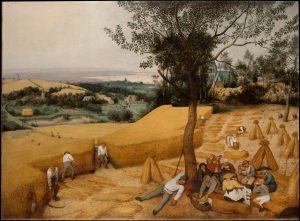
Pieter Bruegel the Elder (The Netherlands, 1525 – 1569), The Harvesters, 1565, oil on wood, 46 x 53 inches. Metropolitan Museum of Art, New York
INTRODUCTION:
Modern art begins in the middle of the 19th Century, in the 1850s, and lasts until approximately the 1960s. After that, once the vocabulary of modernism has been established and fully explored, the art made in the 1970s and 1980s is called post-modern art. Art made within the last 15-20 years is generally called contemporary art.
PART 1: Before we get to the first modern artists and modern style of painting, called Impressionism, we will spend this week reviewing major terms and important concepts that are fundamental to discussing and analyzing works of art.
On smarthistory.org, from the ‘Start Here’ banner at the top, select the ‘Tools for Understanding Art’ drop-down menu and from there, watch four short videos that each explain a central feature in the making of Western art. (LINK to ‘chiaroscuro’ video: http://smarthistory.org/chiaroscuro-explained/)
The four terms are: chiaroscuro, foreshortening, linear perspective and atmospheric perspective. Each video explains a central characteristic of painting that developed during the Renaissance and remained in use until the modern era resulting in artworks appearing naturalistic or extremely life-like in their appearance. Since these techniques for making images were used by artists for several centuries leading up to the modern era, we must understand their role in image making in order to understand why it was such a major shift when modern artists began to break these visual rules and pushed back against the expectation of naturalistic and illusionistic images that usually featured an important historical event, a person of national importance or a religious subject.
For each term, in your notes, write down a short definition in your own words of what the term means and how it functions or what it does within a painting. Use the week #1 powerpoint slides 2 – 12 to review the use and meaning of these terms.
Keep in mind that these techniques are not used individually, but employed together to depict objects and provide structure within images so that the artwork appears illusionistic of real space and so that forms appear to have volume and mass as in real life. It is often good to think in terms of opposites – use of these techniques is what makes artworks appear to be three-dimensional rather than appearing to be flat and two-dimensional, like the canvas on which they are painted.
PART 2: Read and carefully review the terms and concepts on the preliminary document (Word) (6 pages) to familiarize yourself with various terms and concepts related to making art. If anything is unclear, bring your specific questions to class next week to clear up.
Complete the terms and concepts worksheet (PDF) (3 pages) of short answer questions in which you will be applying many of these terms and concepts to artworks included in the introductory week #1 powerpoint on Blackboard. Bring the completed worksheet to class ready to use and review in class as a physical document, not on a device.
PART 3: Read two short essays and complete the following note taking exercise based on the contents of these essays:
- Optional: To bring you up to date historically to the beginning of the modern era, it is highly recommended/suggested that you read or skim the essay ‘A Brief History of Western Culture’ on smarthistory.org if you feel you need general historical background: Link: https://www.khanacademy.org/humanities/art-history-basics/beginners-art-history/a/a-brief-history-of-western-culture (After reading the essay, take a look at my notes (Word) as written for this essay as a guide or template for taking concise, targeted notes. We will be doing many note-taking exercises this semester.)
- ‘Becoming Modern’ essay on khanacademy.org: LINK: http://www.khanacademy.org/humanities/becoming-modern/intro-becoming-modern/a/becoming-modern
- On the MoMA’s website, read the overview ‘What is Modern Art’ and read each of the five sub-categories listed along the left side menu. LINK: https://www.moma.org/learn/moma_learning/themes/what-is-modern-art
NOTES: Compile thorough yet concise and very short notes of the contents of these two required essays. For ‘Becoming Modern’, keep notes divided into the 8 sub-categories used in the essay, beginning with the introductory paragraphs then followed by 7 subheadings using the essay’s subheading words starting with ‘capitalism’. If you do not know the meaning of a term or word, look it up and include a definition written in your own words.
For each category, pull out only the most important and defining individual words or short phrases that relate to the subheading to compile information about what it means to be modern.
For the MoMA essay ‘What is Modern Art’, add information from this essay into your existing notes in the relevant categories or make a new category. Then, read each of the 5 sub-categories in the menu along the left side beginning with ‘Painting Modern Life’. Again, keep concise and very short, targeted notes adding only the new key words and information. If material relates to an established category from the ‘Becoming Modern’ essay, add it there and make new sub-categories for entirely new content with a new heading. If you need to look up a word’s meaning on dictionary.com, do it.
For the next class #2 – summary of the 2 required things to do:
- Read and take notes for each area as explained above for all assigned essays and videos and carefully read the terms and concepts document.
- Bring the completed worksheet of short answers for the terms and concepts for in-class review. Have this on-hand as a physical piece of paper, NOT on an electronic device.
Remember / FYI:
- The powerpoints are always on Blackboard, not on this wordpress site.
- The terms and concepts document and worksheet are only available via the links above.


